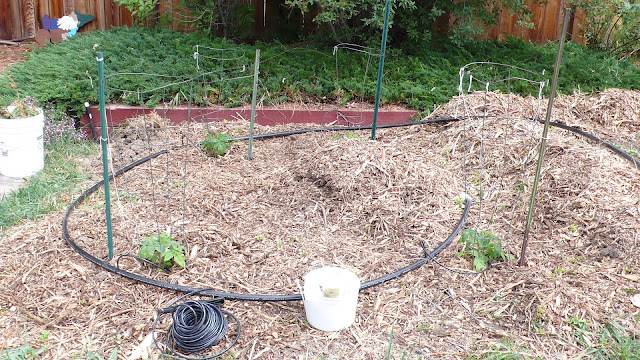I counted the existing sprinklers and bought new risers 12 to 18 inch long to make sure my new piping was above ground with plenty of room to work around. I'm not sure if I over did the height as I've tripped a couple of times already, but I have a very thick layer of mulch to conserve moisture and help control weeds.
 |
| Carrot / radish bed |
 | ||
| Carrots radish carrots with sprinklers |
I bought several different types of emitters (sprinklers), hose and fittings.
The longer spike on the right has a spray head with a strip pattern. I like this type for my carrots, radish, and corn rows. The smaller pattern sprayers and drippers I used for tomatoes and cucumber. The idea is to put the water only where you want it without buying a zillion different ends. They do make drip hose in both the kind that weeps and some that has holes at regular spacing but I haven't had good luck with those because I cant adjust the flow rate.
To the top of the risers I connected barbed fittings for 3/4" funny pipe. I think its called funny pipe because you can bend it. Since it comes in a pretty tight roll it was never very ""funny" for me even though I left it in the sun for a while. Left on its own it wants to form a circles so I put large rocks and cement blocks on it to help keep it in place. This is the same stuff that is usually buried, in which case the soil will hold it in place.
 |
| Taller riser with 90 degree elbow |
Then you pierce the 3/4" funny pipe with a nail or the special tool (which is an expensive plastic nail) and insert a 1/4 inch coupler, 1/4" delivery hose, and the emitter you select.
Here is a close-up of a roma tomato with a small spray emitter.
And a shot of the 4 Roma's. They were started indoors from seeds from Botanical Interests. Tomato Bush-Italian Roma. botanical interests italian roma
The package says, "up to 200 fruit per plant" so I'm hoping for 800 juicy babies.
I tried to leave extra length in the 3/4" funny pipe as the design of the garden will change from year to year and while its pretty easy to remove the 1/4" delivery hoses and plug the holes I'll try to reuse everything next year, a plan I wont ever start considering until next winter has me yearning to get back outside.
I have the crimping tool to allow me to use the low cost crimp on hose clamps, but you can see above that sometimes I don't crimp it right the first second or third time and have to use a standard tractor style hose clamp.
I also used different style hose barbs based on my needs, and what I could use without another trip to the hardware store. Several of the risers were not needed and just capped.
 |
| Tee fitting |
 |
| Octopus fitting |
After installing all the connectors I turned on the water and adjusted to flow and in some cases the location or direction of each emitter to where I thought it needed to be. These may have to be adjusted as the plants grow and either block the flow or need more water.




No comments:
Post a Comment